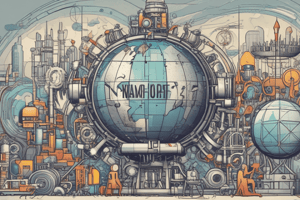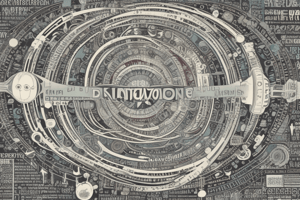Podcast
Questions and Answers
What characterizes innovation in a business context?
What characterizes innovation in a business context?
- A novel and useful idea that is successfully implemented (correct)
- A method of maintaining existing practices
- An approach that limits creativity and risk-taking
- A repetitive process involving standard procedures
Which of the following types of innovation is primarily focused on creating entirely new markets?
Which of the following types of innovation is primarily focused on creating entirely new markets?
- Disruptive Innovation (correct)
- Incremental Innovation
- Architectural Innovation
- Radical Innovation
In what situation can an innovation be adopted as a standard?
In what situation can an innovation be adopted as a standard?
- When the innovation is launched in a monopolistic market
- When market demand is not met by effective substitutes (correct)
- When competitors can easily replicate the innovation
- When no marketing strategy is employed
What is the significance of understanding different types of innovation?
What is the significance of understanding different types of innovation?
What aspect of innovation does the VRIO framework primarily address?
What aspect of innovation does the VRIO framework primarily address?
What is the main characteristic of incremental innovation?
What is the main characteristic of incremental innovation?
Which of the following is an example of a radical innovation?
Which of the following is an example of a radical innovation?
Disruptive innovation primarily targets which market segment?
Disruptive innovation primarily targets which market segment?
What is a strategic implication of disruptive innovation?
What is a strategic implication of disruptive innovation?
Architectural innovation is characterized by which of the following?
Architectural innovation is characterized by which of the following?
What is a key reason for pursuing incremental innovation?
What is a key reason for pursuing incremental innovation?
How can firms guard against disruptive innovations?
How can firms guard against disruptive innovations?
What does the industry life cycle diagram primarily illustrate?
What does the industry life cycle diagram primarily illustrate?
What is a potential advantage of being a first mover in a market?
What is a potential advantage of being a first mover in a market?
Which of the following best describes the role of early followers in a market?
Which of the following best describes the role of early followers in a market?
What typically characterizes a late mover's strategy?
What typically characterizes a late mover's strategy?
What can lead to a technological paradigm shift?
What can lead to a technological paradigm shift?
What does the term 'discontinuity' refer to in the context of technological innovation?
What does the term 'discontinuity' refer to in the context of technological innovation?
In predicting innovation-induced discontinuities, what limitation must companies consider?
In predicting innovation-induced discontinuities, what limitation must companies consider?
Which factor may NOT be a strategic implication for early followers?
Which factor may NOT be a strategic implication for early followers?
What is a likely characteristic of a company like Terrafugia in the context of market entry?
What is a likely characteristic of a company like Terrafugia in the context of market entry?
Flashcards
Innovation Definition
Innovation Definition
A novel and useful idea successfully implemented, impacting a company's core competencies.
VRIO Framework
VRIO Framework
A framework for evaluating if innovation creates a competitive advantage (valuable, rare, imitable, and organized).
Incremental Innovation
Incremental Innovation
Small improvements that build on existing technology and market.
Disruptive Innovation
Disruptive Innovation
Signup and view all the flashcards
Innovation Standard Adoption
Innovation Standard Adoption
Signup and view all the flashcards
First Mover
First Mover
Signup and view all the flashcards
Early Follower
Early Follower
Signup and view all the flashcards
Late Mover
Late Mover
Signup and view all the flashcards
Product Innovation
Product Innovation
Signup and view all the flashcards
Low-Cost Strategy
Low-Cost Strategy
Signup and view all the flashcards
Technological Paradigm Shift
Technological Paradigm Shift
Signup and view all the flashcards
Discontinuity
Discontinuity
Signup and view all the flashcards
Predicting Discontinuity
Predicting Discontinuity
Signup and view all the flashcards
Radical Innovation
Radical Innovation
Signup and view all the flashcards
Architectural Innovation
Architectural Innovation
Signup and view all the flashcards
Linear Model of Innovation
Linear Model of Innovation
Signup and view all the flashcards
Cost of Innovation
Cost of Innovation
Signup and view all the flashcards
Reverse Innovation
Reverse Innovation
Signup and view all the flashcards
Low-cost Innovation
Low-cost Innovation
Signup and view all the flashcards
Study Notes
Innovation for Competitive Rivalry and Dynamics
- MGT 489 Strategic Management course topic
- Focuses on innovation's role in competitive dynamics
- Explores various innovation types and their strategic implications.
Learning Objectives
- Define innovation: Describe its role in competitive processes.
- VRIO Framework: Innovation as a competitive advantage driver.
- Innovation Types: Learn about incremental, architectural, disruptive, and radical innovation.
- Discontinuities and Paradigm Shifts: Understand these dynamics.
What is Innovation?
- Definition (Baregheh et al., 2009): A novel and useful idea successfully implemented.
- Implications for Core Competencies: Mass production, first-to-market advantages, and difficulty imitating complex technologies.
- Innovation vs. Standardization: Differences in production cost, consumer perceptions, and core competencies.
- Adoptions as Standards: Market demand, lack of more effective alternatives (e.g., PC QWERTY, mobile phone GSM/CDMA).
Identifying Different Types of Innovation
- Two Dimensions: Technology and market (Thursby & Thursby, 2006).
- Incremental: Builds on existing knowledge, steady product/service improvement (e.g., iPhones, drug improvements).
- Radical: Novel methods/materials, new knowledge base, or recombination (e.g., Air conditioners, mobile phones).
- Architectural: Existing parts reconfigured for new markets (e.g., flying cars, Sony Walkman).
- Disruptive: Leveraging new technologies to attack existing markets from the bottom up (e.g., CDs, USB flash, LCDs).
Strategic Implications
- Incremental Innovation: The linear model of innovation, cost of innovation.
- Disruptive Innovation: Allows innovators to outperform incumbents, creates threats.
- Strategies for Disruptive Innovation: Reverse innovation, introducing lower cost innovations.
Innovation and its Implications for Strategy
- Industry Life Cycle: Stages relating to innovation (introduction, growth, maturity, decline).
- Understanding timing of market entry (first mover, early follower, late mover).
- First Mover Advantages: Premium price, entry barriers, market monopolization.
- First Mover Disadvantages: Market uncertainties, high innovation costs.
- Early Follower Strategy: Strategic implications (e.g. product innovation, cost-strategy approaches).
- Case Study: Analysis of Apple TV vs Google Chromecast.
- Specific Example (e.g., Terrafugia): Evaluating first mover or standard-setter status.
Discontinuities and Paradigm Shifts
- Technological Paradigm Shifts: New technologies revolutionising industry structure and maturity stages.
- Architectural, Radical, and Disruptive Innovation: Crucial elements in paradigm shifts.
- Discontinuity Period: Underlying technological standard changes. Disruptions lead to paradigm shifts, where new technologies replace existing standards in an industry.
- Predicting Discontinuities: Technological limitations, natural resource constraints, environmental considerations (e.g. fuel price concerns).
- Strategic Implications: Discontinuities create opportunities and threats, favor new entrants through new technology, requiring technological and organizational transformation (e.g., Fuji film).
Studying That Suits You
Use AI to generate personalized quizzes and flashcards to suit your learning preferences.
Related Documents
Description
This quiz explores the critical role of innovation in competitive dynamics, covering various types of innovation and their strategic implications. It aims to enhance understanding of the VRIO framework and how innovation acts as a competitive advantage in strategic management.




